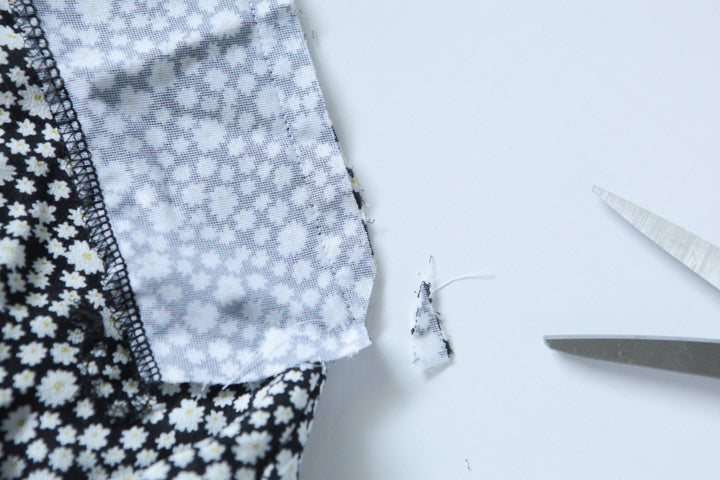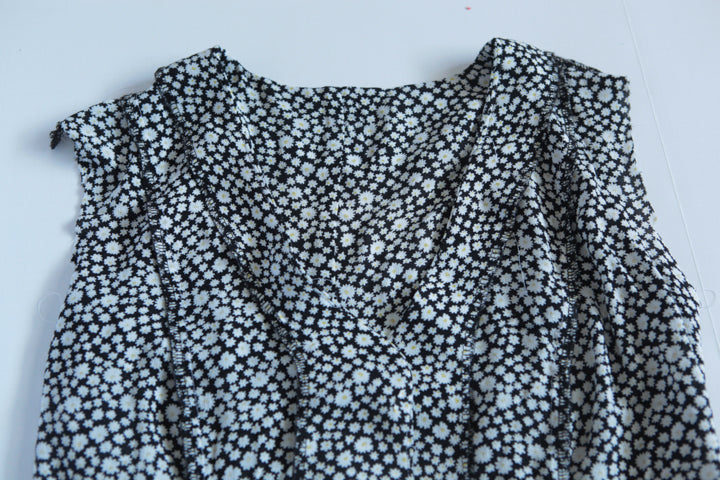Today in the Shelby Sewalong we are going to be attaching the facing. This is probably the hardest part of the instructions, especially if you are sewing up the romper views, so that is all that we are going to tackle today. I recommend taking it slow and pressing often and you should be fine.
First we will go over the steps for the Romper views, if you are sewing up the dress, skip ahead to step 21.
Step 15 - With right sides touching, pin the assembled neck facing to the neck edge of the romper, aligning inner raw edges, and matching shoulder seams, notches, and circles. Sometimes the facing or romper gets a bit stretched out with handling. In this case you will need to ease that back in so pin a lot.

Starting at one circle, stitch around the entire neckline at a normal 1/2" seam allowance, pivoting at the lower corners, and finishing at the the circle on the opposite side. Backstitch at both ends to secure.


This is a tricky step for sure. You need to be extra careful when sewing up to the dot at the bottom of the facing that you are keeping the opposite side out of the way. Otherwise you will get a pucker right there. It's hard to see in the picture but each side should be completely free of the other, but sewn right up to one another at the dots.

Step 16 - The help the neckline have a smooth finish once turned and pressed, grade the neck seam allowance, and notch along the curved portion of the seam. Trim around the center front top curve. The amount of trimming and notching you need to do depends on the weight of your fabric. If its pretty lightweight like mine you don't need to be intense about it, but if your fabric is a bit more structured like a linen, make sure you really grade and trim a lot. This will make a huge difference on how smooth your finished neckline looks once turned.

You also need to trim the angle at each lower corner to reduce bulk once its turned.

Press the unfinished seam allowance below the dot up on each facing so that the raw edge is not exposed once it's turned to the inside of the romper.

Step 17 - To help the facing stay tucked neatly to the inside of the romper, press the seam allowance towards the facing and away from the main romper. Understitch where possible. It is hard to understitch at curves or angles, so I start 1"above the lower edge of the front facing, and understitch to within 1" of the neckline curve. Start again as close as possible to the front edge of the neckline, and stitch around the remainder of the neckline. Continue down the other side of the front facing in the same manner.

Step 18 - Turn the entire neck facing to the inside of the romper, rolling the facing slightly to the inside.

Take extra care in turning out the lower corner to get it sharp. Make sure that the bottom edge of the facing is still turned up and tucked away nicely so no raw edges are showing. Press.

Step 19 - With the romper right side out, lap the right front over the left (when wearing), matching up the centers, and pin. Stitch through all layers 1/8" from the edge to secure.

Step 20 - To help secure the facing to the romper, stitch in the ditch through all layers for a few stitches at the shoulder and center back seams through all layers. You can also do this by hand for less visible stitches.

That is it for the Romper views for today. The rest of the steps are for the Dress views only.
Step 21 - With right sides touching, pin the assembled neck facing to the neck edge of the dress, aligning inner and lower raw edges, and matching should seams and notches.

Starting at the bottom of the dress on one side, stitch along the front opening edge, and around the entire neckline. Finish stitching at the other bottom edge, backstitching at both ends to secure.

Step 22 - The help the neckline have a smooth finish once turned and pressed, grade the neck seam allowance, and notch along the curved portion of the seam. Trim around the center front top curve. The amount of trimming and notching you need to do depends on the weight of your fabric. If its pretty lightweight like mine you don't need to be intense about it, but if your fabric is a bit more structured like a linen, make sure you really grade and trim a lot. This will make a huge difference on how smooth your finished neckline looks once turned.


Step 23 - To help the facing stay tucked neatly to the inside of the dress, press the seam allowance towards the facing and away from the main dress. Understitch where possible. It is hard to understitch at sharp curves or so I start at the bottom of the front facing, and understitch to within 1" of the neckline curve. Start again as close as possible to the front edge of the neckline, and stitch around the remainder of the neckline. Continue down the other side of the front facing in the same manner.

Step 24 - To help secure the facing to the dress, stitch in the ditch through all layers for a few stitches at the shoulder seams. You can also do this by hand for less visible stitches.

That is it, we are done for today. Tomorrow we will take care of the sleeves. We are so close to being finished!


